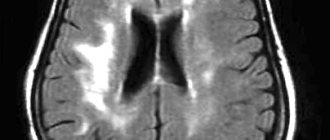Multiple sclerosis is a disease that most often occurs as a result of infectious exposure in a genetically predisposed person, with multiple lesions of the white matter of the brain.
The disease is diagnosed on the basis of characteristic symptoms, and to obtain a more complete clinical picture and establish the group and degree of disability of a patient with multiple sclerosis, a special scale is used - EDSS (EDSS, Expanded Disability Status Scale - an expanded scale for assessing the degree of disability).
In neurological practice, rating scales proposed by John Kurtzke, an American neurologist, have found widespread use. These systems are used to provide a holistic picture of the condition of people with multiple sclerosis and determine the severity of the disease. For this purpose, special scales have been developed: neurological deficit and extended disability scale, abbreviated as FS and EDSS, respectively.
Regular and extended scales
The FS model is designed to determine the state of the body's conducting systems and includes seven subsections.
Each of them is presented in the form of a point gradation of violations of a certain system according to the severity of the disorder. The sum of points for each scale is calculated separately. The use of the system provides an in-depth understanding of the stage of the disease and allows for constant monitoring of the course of the pathological process.
The expanded EDSS scale is used to determine the degree of disability. This is the most common system for tracking disease progression. The calculation determines the walking index, indicating the patient’s ability to walk a distance of up to 500 meters without anyone’s help, up to 100 meters with an assistant, etc.
The scale of the state of functional systems combines groups of symptoms:
- damage to the optic nerve;
- disorders of the cranial nerves (except for the second pair);
- signs of damage to the pyramidal tract;
- coordination disorders;
- sensitivity disorders;
- pelvic organ dysfunction;
- intellectual disorders.
The system for assessing the degree of disability includes the following parameters:
- presence of minimal symptoms;
- slight weakness, minor gait disturbances;
- moderate weakness, unsteadiness of gait, weakening of voluntary movements;
- complete self-care, relative weakness, ability to stay upright for up to half a day;
- independent movement over short distances, shortened working hours;
- moving only with support;
- independent movement in a wheelchair, the patient can sit in it himself;
- restriction of movement to a bed or wheelchair, self-care with hands;
- complete helplessness, the patient is chained to the bed.
EDSS scale. Assessment of manifestations of multiple sclerosis
With all the variety of symptoms of multiple sclerosis, an objective assessment of the clinical status of patients is mandatory. For these purposes, the Expanded Disability Status Scale (EDSS) . EDSS allows you to track changes in disability status over time. The scale is widely used in clinical research and assessment of patients with multiple sclerosis [1, 2].
The EDSS method was developed by neurologist John Kurtzke in 1983 [2].
The Kurtzke assessment allows you to:
- objectively assess the clinical manifestations of the disease;
- prescribe certain medications;
- predict the further course of the disease;
- determine the priority of choosing certain therapeutic strategies.
This scale evaluates the severity of symptoms in points from 0 to 10 in increments of 0.5 units [2].
An EDSS score of 1.0 to 4.5 corresponds to patients being able to move and care for themselves independently. It is made based on an assessment of various functional systems of the body [2]:
- pyramidal - weakness or difficulty moving the limbs;
- cerebellar - coordination problems, tremor;
- brainstem - speech disorders, swallowing and nystagmus;
- sensory - numbness, loss of sensitivity;
- bladder and intestines;
- change in intellectual abilities - thinking;
- visual.
Grades from 5 to 8 are assessed based on motor abilities [2].
| EDSS |
| 1.0 - no violations 1.5 - no violations |
| 2.0 - minimal impairment, outpatient 2.5 - mild impairment, outpatient |
| 3.0 - moderate impairment, outpatient 3.5 - moderate impairment, outpatient |
| 4.0 - relatively severe weakness, can be in an upright position for up to 12 hours a day, fully cares for oneself, can walk 500 m without assistance and rest 4.5 - requires minimal assistance, can work full day, walk 300 m without assistance and rest |
| 5.0 - can walk 200 m without assistance and rest, it is difficult to work full time 5.5 - can walk 100 m without assistance and rest, cannot work full time |
| 6.0 - unilateral support for walking a distance of 100 m 6.5 - constant support on 2 sides for walking 20 m without rest |
| 7.0 - cannot walk 5 m with assistance, but can move in a wheelchair all day 7.5 - needs assistance in moving in a wheelchair, cannot stay in it all day |
| 8.0 - limited to bed or chair, self-care with hands 8.5 - limited to bed or chair, uses hands effectively, but has difficulty self-care |
| 9.0 - bedridden, requires constant care, communication and eating are possible 9.5 - helpless, speech and swallowing are impaired. |
When the clinical picture worsens, an increase in the EDSS scale by 0.5-1 points is most often noted, while a decrease in EDSS by one point means an improvement in the condition or stabilization of the process [2].
In practice, the EDSS scale is used to select the optimal treatment tactics for DMTs (a group of drugs that modify the course of multiple sclerosis) [1].
DMT drugs are prescribed to patients whose EDSS score does not exceed 6.5.
Interesting fact
Most people with multiple sclerosis do not progress to high levels of disability.
There is a misconception among patients and some doctors that the disease will inevitably lead to severe disability in the near future after diagnosis, but this view of the prognosis of MS is not correct. If treatment is started promptly, most patients with MS are able to ambulate independently without assistance and may have minimal neurological deficits. Many patients with MS remain able to work throughout their lives and become disabled only temporarily, during the period of exacerbation of the disease [3, 4].
The use of the EDSS disability scale allows one to assess the degree of damage to various functional systems of the body and select appropriate therapy individually for each patient [5]. This helps to delay or avoid the disability of a patient with multiple sclerosis.
Interpretation of results
EDSS scale (clickable)
Functional systems are assessed for each parameter separately. If all subsections receive 0 points, then there are no changes. Visual function is assessed from 0 to 6 points, brainstem functions - up to 5 points, pyramidal - up to 6, cerebellar - up to 5, sensory - up to 6, pelvic organs - up to 6, intellectual function - up to 5.
When determining damage to the optic nerve, the assessment is made in the worse eye. Before this, the patient is examined by an ophthalmologist: he determines visual acuity and fields, and checks the fundus.
Signs of damage to the pyramidal tract are determined by the most affected limb. If the patient complains about something, but there are no visible changes, one point is assigned. When assessing sensitivity, pain, temperature and one's own sensations are taken into account. Vibration sensitivity is determined using a tuning fork. Subjective complaints of patients about a burning sensation and tingling sensation in the extremities are not taken into account.
When analyzing intellectual function, depressive and euphoric manifestations are assigned 1 point.
The presented system analysis creates the basis for determining the degree of disability of a person. Next, the doctor moves on to the expanded EDSS scale, taking into account previously identified disorders. The EDSS system is also used in multiple sclerosis to understand whether the treatment is having a positive effect or not.
The fundamental indicator of the expanded scale is the patient’s ability to move independently. If he can walk half a kilometer or more without assistance, the values for all functional systems are added up. If a person is able to walk up to five hundred meters on his own, the main attention switches to the walking function (4.5 points on the extended scale or more). The degree of disability according to the EDSS of less than four points corresponds to people who walk independently over five hundred meters, while the exact degree is confirmed by points of the FS system.
Grades between four and five points are determined by both the distance traveled and the level of functional impairment. The basic rule when calculating is that the score is determined by the lesser of these two parameters.
Grades from 5.5 to 8 points are characterized only by the distance traveled, the use of a wheelchair or the assistance of others.
The result of the extended EDSS scale should not be less than any of the functional system indicators (with the exception of visual function and pelvic organ function).
Grades 6-6.5 include both additional support and distance traveled. If a person walks over one hundred meters on crutches or with two canes, he is assigned stage 6. If he walks with the specified devices over ten meters, but not more than one hundred, disability is assessed at 6.5 points.
So, we can say that the extended scale is a kind of continuation of the FS model. This is the so-called “scale within a scale”. Without a preliminary analysis of functional systems, it is not possible to establish the degree of disability.
The lowest EDSS score (0 points) means the absence of neurological symptoms. Patients who score 1-4.5 points are able to fully care for themselves. A score of 7 points or higher indicates a person’s deep disability.
Disability group
The EDSS scale allows you to assign one or another degree of disability for multiple sclerosis:
- 3-4.5 points – third group;
- 5-7 points – second;
- 7.5-9.5 – first.
The network provides online EDSS calculators that allow you to get tested if you suspect you have multiple sclerosis.
Interpretation of assessment results
Based on the obtained value, the results are interpreted in accordance with the table:
| no neurological pathologies have been identified, the patient is considered healthy; | |
| 1.0 | disability is not detected, but there are deviations in one of the systems; |
| 1.5 | the patient’s disability has not been detected, but there are defects in several functional systems; |
| 2.0 | there is minor disability that does not cause discomfort to the patient; |
| 2.5 | “mild” disability is observed in one system or there are minimal deviations in several systems of the patient’s brain or spinal cord; |
| 3.0 | There is moderate disability in one or minor disability in 3-4 systems. The individual does not require hospital treatment; |
| 3.5 | the manifestation of symptoms continues to increase, the patient does not require hospital treatment; |
| 4.0 | the patient receives treatment, leads a normal active life, and is able to independently walk more than 500 meters; |
| 4.5 | the patient receives treatment, leads a normal life, is able to walk independently up to 300 meters; |
| 5.0 | the quality of human life is noticeably reduced, the individual is able to overcome up to 200 meters, it is necessary to reduce the length of the working day; |
| 6.0 | to move a distance of up to 100 meters, the patient must use a stick; |
| 6.5 | the patient needs to use a walker or crutches to overcome a distance of 20 meters; |
| 7.0 | the patient is practically unable to move short distances up to 7 meters; |
| 7.5 | the patient needs to use a wheelchair; |
| 8.0 | the patient spends most of the day in bed, movement is almost impossible, the patient is capable of self-care; |
| 8.5 | during the day the patient is in bed and loses the ability to self-care; |
| 9.0 | the patient remains exclusively in bed, the ability to communicate is preserved; |
| 9.5 | the person loses the ability to communicate; |
| 10.0 | death due to the development of multiple sclerosis. |
Pros and cons of the Kurtzke system
The EDSS system proposed by Kurtzke is used all over the world, and Russia is no exception. This technique allows you to carefully and comprehensively analyze the condition of a patient suffering from multiple sclerosis. The expanded index is used at subsequent appointments to track the dynamics of the disease and assess the effectiveness of the prescribed therapy.
This is the main advantage of the EDSS scale. In addition, EDSS allows you to establish a disability group for multiple sclerosis.
Experts have also identified a number of disadvantages of the Kurtzke method:
- significant emphasis on ambulation;
- the EDSS does not take cognitive dysfunction into account;
- the complexity of the calculation and, as a consequence, the ambiguity of the result obtained;
- the model does not take into account changes in state during a long-term pathological process.
How to apply for and receive disabled status?
Only neurologists who are members of the expert commission (IEC) can legally assign disability for multiple sclerosis, and only after the patient has undergone a special full examination.
The attending physician at the place of residence should refer you for such an examination . In this case, the commission can be carried out both in a medical institution (if the patient is able to move) and at home (with bed rest).
When undergoing such an examination, you will need to prepare the following documents and their photocopies:
- identification document;
- referral for examination (form 0-88/у);
- medical documents confirming the presence of the disease (outpatient card, conclusions of highly specialized specialists, photographs, etc.);
- work book (if available);
- ITU certificate (during re-examination).
As a result of the examination, the patient is assigned a certain degree of disability for a period of usually one year.
Then, at certain intervals (usually once a year), this disability group will need to be confirmed or a new one issued if your health worsens. Also, such a person must receive social benefits established by law.
Evaluation of functional systems
According to Kurtzke, the functions of the following systems are assessed:[2]
- Vision
- Brain stem
- Pyramid system
- Cerebellum
- Sensory system
- Pelvic organs
- Thinking
FSS
FSS
— Kurtzke functional systems status scale[2]
| Group of symptoms | Classification depending on the degree of dysfunction (scores) |
| Optic nerve lesions | 1. Scotoma, visual acuity better than 0.6 2. Worse eye with scotoma with maximum visual acuity of 0.6 to 0.4 3. Worst eye with large scotoma or moderate narrowing of visual fields, but with maximum visual acuity of 0 .4 to 0.2 4. Worse eye with significantly reduced visual fields and a maximum visual acuity of 0.2 to 0.1 or symptoms from section 3 plus a maximum visual acuity of the better eye of 0.4 or less. 5. Worse eye with maximum visual acuity below 0.1, or symptoms from section 4 plus visual acuity of the better eye of 0.4 or less 6. symptoms from section 5 plus visual acuity of the better eye 0.4 or less |
| Disorders of cranial nerves (except II pair) | 1. Symptoms without dysfunction. 2. Moderate nystagmus or other minor disturbances. 3. Severe nystagmus, clear symptoms of involvement of the oculomotor or facial nerves, moderate symptoms of damage to other cranial nerves. 4. Severe dysarthria or other severe impairments. 5. Inability to swallow or speak. |
| Symptoms of damage to the pyramidal tract | 1. Pathological pyramidal reflexes without loss of strength. 2. Slight decrease in muscle strength. 3. Minor or moderate hemi- or paraparesis (weakness, but regarded as increased fatigue while maintaining basic functions after a short rest), severe monoparesis (significant loss of function). 4. Clear hemi- or paraparesis (with impaired function), moderate tetraparesis (function is significantly restored after a short rest). 5. Paraplegia, hemiplegia or distinct tetraparesis. 6. Tetraplegia. |
| Coordination problems | 1. Neurological symptoms without dysfunction. 2. Minor ataxia (functions are practically not affected, but intention tremor or missed hits are clearly detected in tests). 3. Moderate ataxia of the trunk or limbs (tremor and dysmetria make movements difficult). 4. Severe ataxia in all limbs (directed movements are very difficult to perform). 5. Inability to perform directed movements due to ataxia. |
| Sensory disorders | 1. Decreased vibration and muscle-joint sensitivity on one or two limbs. 2. Some decrease in tactile, pain or pressure sensation and/or a moderate decrease in vibration sensitivity in one or two limbs, or only a decrease in muscle-articular sensation in three or four limbs. 3. A distinct decrease in tactile, pain or pressure sensation and/or loss of vibration sensitivity on one or two limbs or a slight decrease in tactile, pain and/or a moderate decrease in all proprioceptive sensitivity on three or four limbs 4. A significant decrease in tactile, pain or loss of proprioception (or in combination) in one or two limbs, or a moderate decrease in tactile, pain sensitivity and/or severe impairment of proprioception in more than two limbs 5. Loss of sensation in one or two limbs, or a moderate decrease in tactile or pain sensitivity and/ or loss of proprioception over the entire body below the head 6. Loss of all types of sensation below the head |
| Disorders of the pelvic organs | 1. Minor urinary disturbances (imperative urges or delays). 2. Moderate delays, urgency, constipation or rare episodes of incontinence. 3. Frequent episodes of urinary incontinence. 4. The need for constant catheterization and constant additional measures for intestinal evacuation. 5. Complete urinary incontinence. 6. Complete incontinence of urine and feces. |
| Changes in intelligence | 1. Memory loss (does not affect performance). 2. Slight decrease in intelligence. 3. Moderate decrease in intelligence. 4. Noticeable decrease in intelligence. 5. Dementia. |










